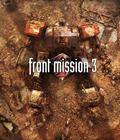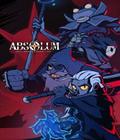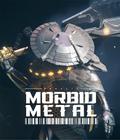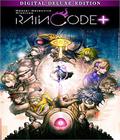In Master Detective Archives: Rain Code+, players wake up in the shoes of the improbably named Yuma Kokohead. Yuma awakens with amnesia, and before he can get his bearings, he's shuffled onto a train. That's where he discovers that he is a member of the World Detective Organization, a group of independent super-detectives who solve mysteries. The very best have been summoned to Kanai Ward, an isolated city belonging to the Amaterasu mega corporation. Murders have occurred, and Yuma must push through his amnesia to solve the mysteries. Thankfully, he has one advantage: Before his amnesia, he made a contract with the God of Death, Shinigami, who's presented in the game as a murder-happy magical girl. Shinigami can't be seen or interacted with by anyone but Yuma, but her special powers offer him the chance to solve mysteries that nobody else can. Together, Yuma and Shinigami team up to learn the truth about the Kanai Ward before Yuma meets his own untimely fate.
Rain Code has a lot of instant comparisons in terms of tone and characterization to Danganronpa, but it's a more expansive area and a more "alive" world. The rain-soaked, corporate-owned dystopian city is an appealing location. Unfortunately, the strong setting is let down by the characters. Danganronpa lived and died (literally) by its active and busy cast. Rain Code has a bad habit of introducing and then removing characters from the story at such a rapid pace that it's impossible to get attached. Instead of a constant cast that builds and plays off one another, you're stuck with Yuma, Shinigami and perhaps one supporting cast member. You explore mysteries that focus on brand-new characters who get perhaps five lines of dialogue before a murder occurs. Amaterasu villains are introduced and dispatched so quickly they may as well be disposable mooks. In general, the game suffers from not committing to a defined cast.
This negatively impacts the mysteries because there's very little room to develop red herrings or complex motivations. You can figure out the killer and motives within moments, and that drains the fun out of the bizarre murder situations. One chapter is poorly paced and gives you the exact clues necessary to solve the murder within two minutes. However, it's followed by another hour of faffing around while trying to find the killer's motivation, which feels disconnected from the murder.
It is a shame because the game is strongest when you have the larger casts. Having the various detectives together tends to work much better than having one specific partner, and mysteries that involve characters who have been around for longer than two minutes hit much harder than those that don't. It's very easy to see the Danganronpa-style spark at those moments, but that makes it more frustrating when the deviations from that formula don't work.
The plot has some really effective moments. Focusing on corporate greed and abuse and how it destroys the lives of innocent people makes for an effective concept. Although the game takes some sharp turns into crazytown, it allows for some chilling moments when you see innocent people utterly destroyed by heartless malice. The characters can also be fun when they're allowed to shine, and I think the game would've done wonders by giving more screen time to the non-Yuma detectives.
As for gameplay, Rain Code plays a little like Danganronpa on fast-forward. The game is divided into various segments, with each segment involving exploring the town, gathering clues about the murders, and then a Mystery Labyrinth where you put together the clues to figure out who did it. It's much faster paced than Danganronpa in that there's no downtime. Every chapter hops very quickly into the murders, so there's less time spent hanging out and developing characters in favor of the "meat" of the game. There are side-quests to flesh out the world, but they usually involve going to a location, talking to a person, and getting a reward.
As far as the actual mystery-solving goes, it's almost identical in structure to Danganronpa. You'll go from scene to scene and click pretty much every object on the field to gather clues, which Shinigami promptly converts into magical objects and carries around inside of her to vomit up later. (It's a weird game.) There are some light puzzles, but generally, you're poking around in search of clues. This isn't a huge criticism, as one of the most enjoyable elements of any mystery game is gathering clues. One neat element of Rain Code is that whoever you're partnered with has their own magic powers that Yuma can borrow, allowing you to do things like disguise yourself and rewind time. The powers are mostly locked to specific segments, but it's a nice way to add variety to the clue-gathering process.
Where Rain Code shines is in the Mystery Labyrinth segments. Once Yuma gathers enough clues, Shinigami pulls him and whoever he is partnered with into the Mystery Labyrinth. It's a bizarre, garish maze created from the very essence of whatever murder they are trying to solve, with the soul of the true culprit housed at its center. To discover the culprit, Yuma must make his way through a nightmare realm of traps, puzzles and ghosts that can only be overcome by figuring out the ins and outs of the mystery.
For the most part, this is a super fancy way of handling answering questions via fast-paced minigame, usually in a goofy and gruesome fashion. Need to think about what weapon was used to murder the victims? It presents as Yuma jumping across a collapsing bridge and needing to select the correct step to hop to, and each step is emblazoned with a potential answer to the mystery. Need to come to a series of quick conclusions? It will be shown as a frantic minecart ride where you have moments to pick the correct answer, or Yuma and friends will crash into a wall.
This also comes with a return of the various Danganronpa minigames. The Nonstop Debates are back in the form of Reasoning Death Matches. The best way to describe this is a standard cross-examination that takes the form of an action combat scene. Whoever you are cross-examining will spew their statements at you as if they were physical things, and Yuma must dodge them or take damage. The game rewards you for narrowly dodging these statements with bonus points. The only way to deal damage back is to use one of the clues you found to "slash" one of their statements to prove a flaw or contradiction. As this progresses, additional complexity is added, like "trash" statements you must slash away or flawed statements you have to repel.
I get what the game is going for by adding an active element to the usually dry act of people talking to each other, and it can be fun. However, like Danganronpa's battles, it can get annoying if you're trying to figure out which statement you need to counter. Instead of being able to go back and forth, you have to dodge and avoid attacks. This is in addition to the more standard problem with these sorts of games, which is figuring out exactly which item the game expects you to use on which statement. This isn't an issue if you figure it out right away, but if you get stuck, the fun action elements become an increasingly tedious roadblock. The game lets you charge up a temporary invincibility mode so you don't have to dodge, but that's more of a band-aid than a solution. The puzzles are usually simple enough, so it isn't a huge issue.
The other minigames are better paced, since they tend to not drag on. They include returning versions of Danganronpa games like Hangman's Gambit (retitled Shinigami's Puzzle) and the create-a-comic Closing Arguments. They also include some new minigames, such as God Shinigami, where Yuma rides a giant version of Shinigami as she busts through barriers and keeps the heroes from the culprits. Most of these are fun enough, and even the ones I didn't enjoy rarely last long enough to be an issue.
Despite my complaints about some elements, the Mystery Labyrinth is a fantastic way of adding more flavor to solving mysteries. The gradual exploration of the fantastic dungeons and the near-constant shift between different environments, areas and gameplay types adds an extremely fun atmosphere. There are some flaws and areas where it could've been smoothed out, but I looked forward to every Mystery Labyrinth.
Rain Code is very much a game built on the same kind of visual stylings as Danganronpa, with almost the same kind of aesthetic and visual flourishes, right down to blood being presented as a neon pink splash. The 3D models look rather nice, and the environments are beautifully crafted. The music is excellent, and the voice acting largely hits the mark. Shinigami's frequently unhinged performance goes a long way toward making a character enjoyable when they could be intolerably annoying, and there are a lot of solid performances throughout.
Master Detective Archives: Rain Code+ is a neat approach at taking Danganronpa's core concept and taking it outside of the Battle Royal Death Game world. There are a lot of extremely strong concepts, and when they come together well, it's easy to see how this could've eclipsed even its ancestor. Unfortunately, things are a tad too muddled, too simple, and too divorced from one another to be a cohesive whole. If you're a fan of the Danganronpa titles, then it's worth a shot. Otherwise, I'd recommend starting with one of those before Rain Code.
Score: 7.0/10
More articles about Master Detective Archives: Rain Code











 Master Detective Archives: Rain Code Plus is an all-new dark fantasy mystery game developed by the team that created the Danganronpa game series.
Master Detective Archives: Rain Code Plus is an all-new dark fantasy mystery game developed by the team that created the Danganronpa game series.

























